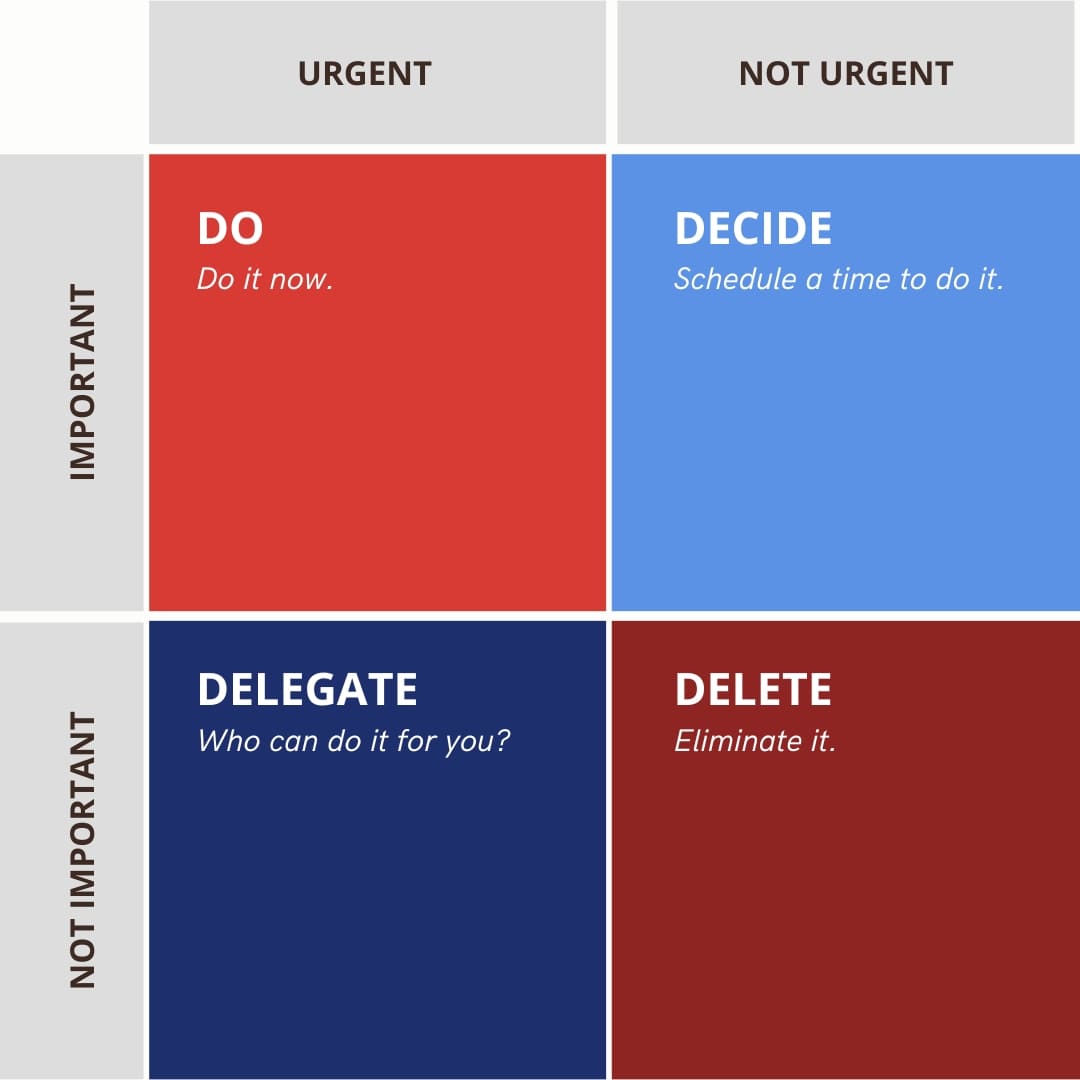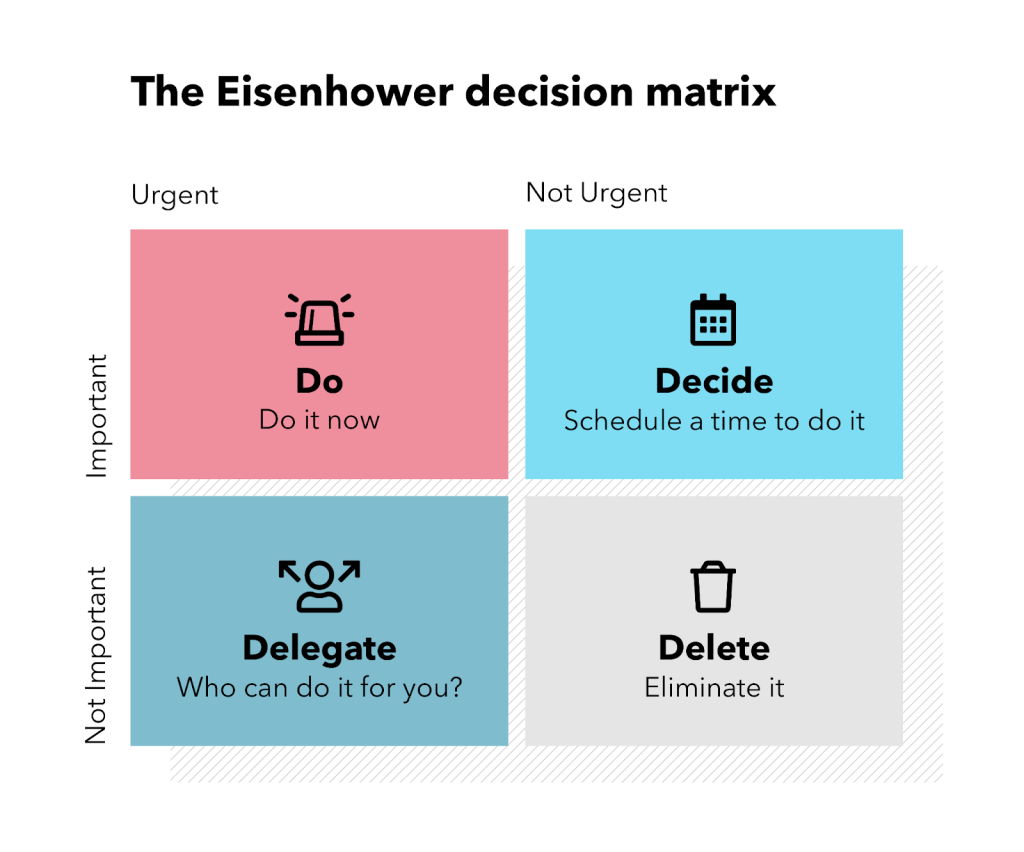
Time management is like that one friend in your group who’s quiet as a mouse but their presence is only felt when they’re not around. It’s a skill that everybody strives to achieve but very few hone and accomplish. Procrastination, being one of the biggest enemies of time management, takes over like a plague for most of us. When it does, we’re usually left with self-disappointment and a void in the end.

But with some pre-planning and mindfulness, we can effectively combat this and emerge victorious – not in the eyes of others but for ourselves. To help you regulate your time and work more effectively, we have introduced an amazing tool in this blog post. This is a commonly known work management tool that has been in the rounds for more than half a century!
That’s right – the Eisenhower Matrix was introduced in the 1950s and continues to be employed, referred to, and thanked for in the present day.
The Eisenhower Matrix
Also known as the Eisenhower Box, the Urgent-Important Matrix, or the Time Management Matrix. It is named after President Dwight Eisenhower, the 34th President of the United States. This tool was not just created by him but also manifested itself in his professional career. Before he became president, he was a 5-star general in the US Army during the Second World War. Throughout his professional life, he brought about many changes that were helpful to the nation.
During his presidency of two terms, the Interstate Highway System was brought into play. NASA was created, and the first-ever civil rights legislation was signed into law. In addition, Alaska and Hawaii were brought into the union, and the Cold War with Russia was, well, maintained as cold. All of this was done with an efficient and calm hand – a solid example of prioritizing tasks. All in all, Eisenhower was a pretty productive guy. That’s a swell reason for having him get the ‘most admired man of the year’ title 12 times by Gallups.
This matrix was made even more popular a few decades later by the self-help genre author Stephen Covey. In his book, “7 Habits of Highly Effective People“, he refers to this matrix as a powerful tool to prioritize tasks and manage time well.
What the Matrix does

Cutting back to the matrix, it is a large square divided into 4 smaller squares. These quadrants are your workboxes, where you divide and segregate tasks in a manner of urgency and importance. Penned down by the president of Northwestern University, Dr. J. Roscoe Miller, Eisenhower quoted in a speech,
“I have two kinds of problems: the urgent and the important. The urgent are not important, and the important are never urgent.”
Against the popular misconception, urgent and important do not mean the same, nor can they be used interchangeably. The urgent tasks are those that need to be done right away, or else they’d have significant consequences for your long-term goals. On the other hand, some important tasks are not urgent but they should be done to achieve your long-term goals. To understand this better, we will break it down into quadrants as seen in the image below:

Understanding the Eisenhower Matrix
Quadrant 1
As the first quadrant mentions, this box would contain all those tasks that you need to DO right away. Filling out a university admission form or signing up for school drama may have tight deadlines. On a personal level, responding to a fire caused during unsupervised cooking demands immediate attention.
At work, it’s crucial to time yourself with urgent tasks. Spending too much time on them can leave little room for other quadrants, resulting in a messy situation.
With the exams coming up, we’re sure you have a lot of tasks to fill into the first quadrant! But, if you schedule them beforehand, you can avoid getting into a last-minute panic mode that would eventually burn you out. So choose wisely!
Quadrant 2
The second quadrant, also known as the SCHEDULE box, holds tasks that are important but not urgent. For instance, exercise is crucial for health, but not doing it in the next hour won’t turn you into a lazy blob instantly. Well, if you never do it then you might just.
Another example is prepping for your upcoming mock exams – extremely important for next week but so is the urgent assignment that you have to submit in your private tuition class today. You get the drill, don’t you?
Scheduling tasks for the day, week, or month helps prioritize and manage them in advance. This prevents last-minute shifts to the first quadrant.
Quadrant 3
The DELEGATE box, or Quadrant 3, is the section where you add tasks that are urgent but not important. They are not necessary to be done by you, and may not adhere to your skill set. For those delegating tasks, assign them to someone else to ensure timely completion. Examples include having a teacher review assignment feedback or having a sibling walk the dog. If your mother needs urgent help in the kitchen while you’re studying, direct a sibling to assist, and don’t hesitate to ask for help when needed.
Quadrant 4
This box is neither urgent nor important – hence the apt name given to it is DELETE. This is the procrastination inducer, a major distraction, the purple little devil ruining your planned day. Mindlessly scrolling through TikTok at dawn, ending with your mother screaming from downstairs – you know what we’re talking about.
These would also include binge-watching shows on Netflix or Rakuten Viki or being glued to your gaming consoles for hours on end. Although a short break is essential and rewarding for your long-term goals, this is a tricky and sticky trap that you need to control. A break that lasts very long would end up hampering the rest of the quadrants and giving you unnecessary panic and anxiety to complete your tasks in time.
You might think it’s easier said than done, hence we have listed down a few pointers to help you make use of this powerful tool to its best.
Effectively Applying the Eisenhower Matrix to Everyday Life

Code your tasks with some color or numbering
Make use of colors to separate the boxes and reduce the time given to the matrix itself. For example, quadrant 1 can be green, quadrant 2 yellow, quadrant 3 blue, and quadrant 4 red. Some might find it easier to swap the first quadrant with the color red, as red signifies danger and urgency.
Once you’ve got the hang of the colors, you begin to associate tasks more effectively. You may not always have the means to sit and make boxes all the time, but you can always draw up a list and highlight the tasks according to the colors. Alternatively, you can use numbers. The numbers are synonymous with the quadrant numbers 1, 2, 3, and 4.
Take a look at the example below:

Limit your tasks
If you’ve got too many tasks to do, and if you fill one box with 10 + tasks, there’s a good chance you’re going to flip, plonk up on your bed, and end up doing nothing due to the overwhelmed. An easier solution is to limit the number and focus only on what you can do in the next 12 hours or so. Some work is better than none, hence you must always be realistic with your goals.
Separate the personal from professional
When you have a lot of tasks to do, mixing them all up could be catastrophic to you on a physical as well as mental level. There would be a few days when you’re overloaded with tasks in school as well as at home. Take, for example, a few guests coming over during the term end for a festival like Eid or Diwali to celebrate when you’ve got a main exam the very next day.
As we mentioned before, planning and prepping in advance reduces the workload, but separating your matrices into home chores and schoolwork can make a lot of difference.
Use the power of deduction
To reduce the number of tasks ending up on your to-do list, the first thing you do after making a list is strike off tasks that are unnecessary and insignificant. Why draw them up in the first place? That’s because they consciously help you eliminate actions that would hinder the rest of the tasks. For example, when you know you have to prepare a presentation after 2 days at work or at school, you might end up watching silly videos as a result of procrastination. If you cancel it in advance, you know what you’re not supposed to do.
We hope that this helps you plan and prepare your tasks more efficiently. We’re not saying that the Eisenhower Matrix is perfect, it has its flaws (for e.g. what if you’re an only child?). Whether you’re an adult who has just begun her new job or a grade 10 student who wants to achieve an A grade in their IGCSEs, this matrix is suitable for all ages and we’re sure it would help you well.
References
https://todoist.com/productivity-methods/eisenhower-matrix
https://asana.com/resources/eisenhower-matrix
https://slab.com/blog/eisenhower-matrix/
https://evernote.com/blog/work-effectively-with-the-eisenhower-matrix/
https://corporatefinanceinstitute.com/resources/management/eisenhower-matrix/





